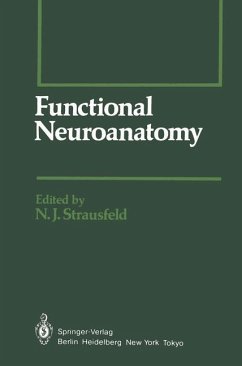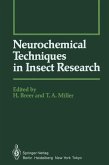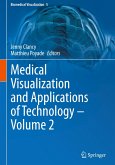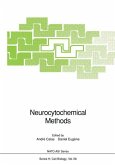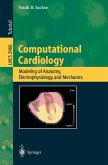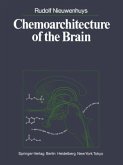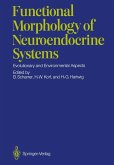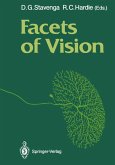Functional Neuroanatomy
Mitarbeit: Adams, M.E.; Altman, J.S.; Bacon, J.P.; Bassemir, U.K.; Bishop, C.A.; Herausgegeben von Strausfeld, N. J.
Functional Neuroanatomy
Mitarbeit: Adams, M.E.; Altman, J.S.; Bacon, J.P.; Bassemir, U.K.; Bishop, C.A.; Herausgegeben von Strausfeld, N. J.
- Broschiertes Buch
- Merkliste
- Auf die Merkliste
- Bewerten Bewerten
- Teilen
- Produkt teilen
- Produkterinnerung
- Produkterinnerung
The "functional" in the title of this book not only reflects my personal bias about neuroanatomy in brain research, it is also the gist of many chapters which describe sophisticated ways to resolve structures and interpret them as dynamic entities. Examples are: the visualization of functionally identified brain areas or neurons by activity staining or intracellular dye-iontophoresis; the resolution of synaptic connections between physiologically identified nerve cells; and the biochemical identification of specific neurons (their peptides and transmitters) by histo- and immunocytochemistry. I…mehr
Andere Kunden interessierten sich auch für
![Neurochemical Techniques in Insect Research Neurochemical Techniques in Insect Research]() Neurochemical Techniques in Insect Research77,99 €
Neurochemical Techniques in Insect Research77,99 €![Medical Visualization and Applications of Technology ¿ Volume 2 Medical Visualization and Applications of Technology ¿ Volume 2]() Medical Visualization and Applications of Technology ¿ Volume 2115,99 €
Medical Visualization and Applications of Technology ¿ Volume 2115,99 €![Neurocytochemical Methods Neurocytochemical Methods]() Neurocytochemical Methods77,99 €
Neurocytochemical Methods77,99 €![Computational Cardiology Computational Cardiology]() Frank B. SachseComputational Cardiology39,99 €
Frank B. SachseComputational Cardiology39,99 €![Chemoarchitecture of the Brain Chemoarchitecture of the Brain]() Rudolf NieuwenhuysChemoarchitecture of the Brain97,99 €
Rudolf NieuwenhuysChemoarchitecture of the Brain97,99 €![Functional Morphology of Neuroendocrine Systems Functional Morphology of Neuroendocrine Systems]() Functional Morphology of Neuroendocrine Systems77,99 €
Functional Morphology of Neuroendocrine Systems77,99 €![Facets of Vision Facets of Vision]() Facets of Vision112,99 €
Facets of Vision112,99 €-
-
-
The "functional" in the title of this book not only reflects my personal bias about neuroanatomy in brain research, it is also the gist of many chapters which describe sophisticated ways to resolve structures and interpret them as dynamic entities. Examples are: the visualization of functionally identified brain areas or neurons by activity staining or intracellular dye-iontophoresis; the resolution of synaptic connections between physiologically identified nerve cells; and the biochemical identification of specific neurons (their peptides and transmitters) by histo- and immunocytochemistry. I personally view the nervous system as an organ whose parts, continuously exchanging messages, arrive at their decisions by the cooperative phenome non of consensus and debate. This view is, admittedly, based on my own ex perience of looking at myriads of nerve cells and their connections rather than studying animal behaviour or theorizing. Numerous structural studies have demonstrated that interneurons in the brain must receive hundreds of thousands of synapses. Many neurons receive inputs from several different sensory areas: each input conveys a message about the external world and possibly also about past events which are stored within the central nervous system. Whether an interneuron responds to a certain combination of inputs may be, literally, a matter of debate whose outcome is decided at the post synaptic membrane. A nerve cell responding to an overriding command is possibly a rare event.
Hinweis: Dieser Artikel kann nur an eine deutsche Lieferadresse ausgeliefert werden.
Hinweis: Dieser Artikel kann nur an eine deutsche Lieferadresse ausgeliefert werden.
Produktdetails
- Produktdetails
- Springer Series in Experimental Entomology
- Verlag: Springer / Springer Berlin Heidelberg / Springer, Berlin
- Artikelnr. des Verlages: 978-3-642-82117-2
- Softcover reprint of the original 1st ed. 1983
- Seitenzahl: 448
- Erscheinungstermin: 21. Dezember 2011
- Englisch
- Abmessung: 235mm x 155mm x 25mm
- Gewicht: 674g
- ISBN-13: 9783642821172
- ISBN-10: 3642821170
- Artikelnr.: 36115904
- Herstellerkennzeichnung Die Herstellerinformationen sind derzeit nicht verfügbar.
- Springer Series in Experimental Entomology
- Verlag: Springer / Springer Berlin Heidelberg / Springer, Berlin
- Artikelnr. des Verlages: 978-3-642-82117-2
- Softcover reprint of the original 1st ed. 1983
- Seitenzahl: 448
- Erscheinungstermin: 21. Dezember 2011
- Englisch
- Abmessung: 235mm x 155mm x 25mm
- Gewicht: 674g
- ISBN-13: 9783642821172
- ISBN-10: 3642821170
- Artikelnr.: 36115904
- Herstellerkennzeichnung Die Herstellerinformationen sind derzeit nicht verfügbar.
1 Electron Microscopy of Golgi-Impregnated Neurons.- I. Introduction.- II. General Description of the Procedure.- III. Results.- IV. Discussion.- V. Appendix: Schedules.- 2 Block Intensification and X-Ray Microanalysis of Cobalt-Filled Neurons for Electron Microscopy.- I. Introduction.- II. Method.- III. Ultrastructure.- IV. Identification of Size and Nature of Precipitate.- V. Discussion.- VI. Applications.- 3 Horseradish Peroxidase and Other Heine Proteins as Neuronal Markers.- I. Introduction.- II. The Versatility of Exogenous Heme Proteins as Neuronal Markers.- III. Chemistry of Peroxidase-Active Proteins and Reactions for their Demonstration.- IV. Methods.- V. Cytology of Peroxidase-Labelled Neurons.- VI. Mechanisms of Neuronal Uptake and Transport of Herne Proteins.- VII. Concluding Remarks.- VIII. Addendum.- IX. Appendix 1: Method.- X. Appendix 2: Solutions.- 4 Intracellular Staining with Nickel Chloride.- I. Introduction.- II. Method.- 5 Rubeanic Acid and X-Ray Microanalysis for Demonstrating Metal Ions in Filled Neurons.- I. Introduction.- II. Use of Different Metal Ions.- III. Rubeanic Acid Development.- IV. Applications of Rubeanic Acid Development.- V. X-Ray Microanalysis for Detection of Metal Ions.- VI. Conclusion.- 6 Double Marking for Light and Electron Microscopy.- I. Introduction.- II. Double Marking for Light Microscopy.- III. Double Marking for Light and Electron Microscopy.- IV. Alternative Strategies.- 7 Lucifer Yellow Histology.- I. Introduction.- II. Filling from Electrodes.- III. Passive Back- or Forwardfilling.- IV. Fixing.- V. Buffers, Ringers.- VI. Whole-Mount Viewing.- VII. Embedding and Sectioning.- VIII. Microscopy.- IX. Photography.- X. Fading.- XI. Reconstructions.- XII. Geography.- XIII. Storage.- XIV. Artefacts.- XV. Conclusions.- 8 Portraying the Third Dimension in Neuroanatomy.- I. Introduction.- II. Why Computer Graphics in Neuroanatomy?.- III. Designing the System.- IV. The NEU System.- V. Alignment of Sections.- VI. Interactive Profile Acquisition.- VII. Noninteractive Operations.- VIII. Final Remarks.- 9 Three-Dimensional Reconstruction and Stereoscopic Display of Neurons in the Fly Visual System.- I. Introduction.- II. Procedure.- III. Hardware Configuration.- IV. The Data Acquisition Program HISDIG.- V. The Reproduction Program HISTRA.- VI. Stereoscopic Vision.- VII. Examples of Displays and Stereopairs.- VIII. Further Applications.- IX. Concluding Remarks.- 10 Laser Microsurgery for the Study of Behaviour and Neural Development of Flies.- I. Introduction.- II. The Laser Microbeam Unit.- III. Procedure of Laser Surgery.- IV. Histological Analysis.- V. Anatomical-Behavioural Correlations of Laser-Eliminated Lobula Plate Neurons.- VI. Aspects of Neuronal Development.- VII. Discussion.- 11 Anatomical Localization of Functional Activity in Flies Using 3H-2-Deoxy-D-Glucose.- I. Introduction.- II. Essentials of the Technique.- III. Results.- IV. Concluding Remarks.- 12 Strategies for the Identification of Amine- and Peptide-Containing Neurons.- I. Introduction.- II. Neutral Red: A Nonspecific Stain for Amine-Containing Neurons.- III. Neutral Red: An Indicator of Peptidergic Neurons.- IV. Permanent Preparations of Vital Staining with Neutral Red.- V. Use of Immunohistochemical Approaches to Neuron Identification.- VI. Immunohistochemical Screening: Whole-Mount Method.- VII. Identification: Immunohistochemistry and Dye Injection.- VIII. Confirmation of Immunohistochemistry: Cell Isolation, Extraction and Assay.- IX. Concluding Remarks.- 13 Immunochemical Identification of Vertebrate-Type Brain-Gut Peptides in Insect Nerve Cells.- I. Introduction.- II. Immunocytochemistry: Basic Principles.- III. Techniques of Immunocytochemistry.- IV. Problems of Specificity.- V. Brain-Gut Peptides in Insects.- VI. Extraction and Purification.- VII. Conclusions.- VIII. Appendix 1: Immunofluorescence: The Indirect Method.- IX. Appendix 2: Immunoperoxidase: The PAP Method.- 14 Immunocytochemical Techniques for the Identification of Peptidergic Neurons.- I. Introduction and Survey.- H. Preparation of Antigens.- III. Production and Isolation of Antibodies.- IV. Absorption of the Antisera Before Use for Immunocytochemistry.- V. Isolation of Hapten-Specific Antibodies.- VI. Methods for Antibody Isolation.- VII. Immunocytochemical Techniques.- VIII. Immunocytochemical Staining Methods.- IX. CoCl2 Iontophoresis and Indirect Immunofluorescence Method.- X. Supplementary Methods.- XI. Electron Microscopy.- XII. Conclusions.- 15 Detection of Serotonin-Containing Neurons in the Insect Nervous System by Antibodies to 5-HT.- I. Introduction.- II. General Considerations of Antibody Staining.- III The Immunofluorescence Technique.- IV. Fluorescence Microscopy and Photography.- V. The Unlabelled Antibody Enzyme Method for Sections.- VI. A Whole-Mount Method for Antibody Staining.- VII. Specificity of Anti-5-HT Labelling.- 16 Monoaminergic Innervation in a Hemipteran Nervous System: A Whole-Mount Histofluorescence Survey.- I. Introduction.- II. Materials and Methods.- III. Results.- IV. Discussion.- 17 Identification of Neurons Containing Vertebrate-Type Brain-Gut Peptides by Antibody and Cobalt Labelling.- I. Introduction.- II. Method.- III. Interpretation of the Results.- IV. Conclusions.- 18 Interpretation of Freeze-Fracture Replicas of Insect Nervous Tissue.- I. Introduction.- II. Procedure.- III. Interpretation of Replicas.- IV. The Cleaved Cell: A Survey.- V. Recent Advances and Future Prospects.- 19 High-Voltage Electron Microscopy for Insect Neuroanatomy.- I. Introduction.- II. Rationale for HVEM for Biological Research.- III. Method.- IV. HVEM of Insect Neurons.- References.
1 Electron Microscopy of Golgi-Impregnated Neurons.- I. Introduction.- II. General Description of the Procedure.- III. Results.- IV. Discussion.- V. Appendix: Schedules.- 2 Block Intensification and X-Ray Microanalysis of Cobalt-Filled Neurons for Electron Microscopy.- I. Introduction.- II. Method.- III. Ultrastructure.- IV. Identification of Size and Nature of Precipitate.- V. Discussion.- VI. Applications.- 3 Horseradish Peroxidase and Other Heine Proteins as Neuronal Markers.- I. Introduction.- II. The Versatility of Exogenous Heme Proteins as Neuronal Markers.- III. Chemistry of Peroxidase-Active Proteins and Reactions for their Demonstration.- IV. Methods.- V. Cytology of Peroxidase-Labelled Neurons.- VI. Mechanisms of Neuronal Uptake and Transport of Herne Proteins.- VII. Concluding Remarks.- VIII. Addendum.- IX. Appendix 1: Method.- X. Appendix 2: Solutions.- 4 Intracellular Staining with Nickel Chloride.- I. Introduction.- II. Method.- 5 Rubeanic Acid and X-Ray Microanalysis for Demonstrating Metal Ions in Filled Neurons.- I. Introduction.- II. Use of Different Metal Ions.- III. Rubeanic Acid Development.- IV. Applications of Rubeanic Acid Development.- V. X-Ray Microanalysis for Detection of Metal Ions.- VI. Conclusion.- 6 Double Marking for Light and Electron Microscopy.- I. Introduction.- II. Double Marking for Light Microscopy.- III. Double Marking for Light and Electron Microscopy.- IV. Alternative Strategies.- 7 Lucifer Yellow Histology.- I. Introduction.- II. Filling from Electrodes.- III. Passive Back- or Forwardfilling.- IV. Fixing.- V. Buffers, Ringers.- VI. Whole-Mount Viewing.- VII. Embedding and Sectioning.- VIII. Microscopy.- IX. Photography.- X. Fading.- XI. Reconstructions.- XII. Geography.- XIII. Storage.- XIV. Artefacts.- XV. Conclusions.- 8 Portraying the Third Dimension in Neuroanatomy.- I. Introduction.- II. Why Computer Graphics in Neuroanatomy?.- III. Designing the System.- IV. The NEU System.- V. Alignment of Sections.- VI. Interactive Profile Acquisition.- VII. Noninteractive Operations.- VIII. Final Remarks.- 9 Three-Dimensional Reconstruction and Stereoscopic Display of Neurons in the Fly Visual System.- I. Introduction.- II. Procedure.- III. Hardware Configuration.- IV. The Data Acquisition Program HISDIG.- V. The Reproduction Program HISTRA.- VI. Stereoscopic Vision.- VII. Examples of Displays and Stereopairs.- VIII. Further Applications.- IX. Concluding Remarks.- 10 Laser Microsurgery for the Study of Behaviour and Neural Development of Flies.- I. Introduction.- II. The Laser Microbeam Unit.- III. Procedure of Laser Surgery.- IV. Histological Analysis.- V. Anatomical-Behavioural Correlations of Laser-Eliminated Lobula Plate Neurons.- VI. Aspects of Neuronal Development.- VII. Discussion.- 11 Anatomical Localization of Functional Activity in Flies Using 3H-2-Deoxy-D-Glucose.- I. Introduction.- II. Essentials of the Technique.- III. Results.- IV. Concluding Remarks.- 12 Strategies for the Identification of Amine- and Peptide-Containing Neurons.- I. Introduction.- II. Neutral Red: A Nonspecific Stain for Amine-Containing Neurons.- III. Neutral Red: An Indicator of Peptidergic Neurons.- IV. Permanent Preparations of Vital Staining with Neutral Red.- V. Use of Immunohistochemical Approaches to Neuron Identification.- VI. Immunohistochemical Screening: Whole-Mount Method.- VII. Identification: Immunohistochemistry and Dye Injection.- VIII. Confirmation of Immunohistochemistry: Cell Isolation, Extraction and Assay.- IX. Concluding Remarks.- 13 Immunochemical Identification of Vertebrate-Type Brain-Gut Peptides in Insect Nerve Cells.- I. Introduction.- II. Immunocytochemistry: Basic Principles.- III. Techniques of Immunocytochemistry.- IV. Problems of Specificity.- V. Brain-Gut Peptides in Insects.- VI. Extraction and Purification.- VII. Conclusions.- VIII. Appendix 1: Immunofluorescence: The Indirect Method.- IX. Appendix 2: Immunoperoxidase: The PAP Method.- 14 Immunocytochemical Techniques for the Identification of Peptidergic Neurons.- I. Introduction and Survey.- H. Preparation of Antigens.- III. Production and Isolation of Antibodies.- IV. Absorption of the Antisera Before Use for Immunocytochemistry.- V. Isolation of Hapten-Specific Antibodies.- VI. Methods for Antibody Isolation.- VII. Immunocytochemical Techniques.- VIII. Immunocytochemical Staining Methods.- IX. CoCl2 Iontophoresis and Indirect Immunofluorescence Method.- X. Supplementary Methods.- XI. Electron Microscopy.- XII. Conclusions.- 15 Detection of Serotonin-Containing Neurons in the Insect Nervous System by Antibodies to 5-HT.- I. Introduction.- II. General Considerations of Antibody Staining.- III The Immunofluorescence Technique.- IV. Fluorescence Microscopy and Photography.- V. The Unlabelled Antibody Enzyme Method for Sections.- VI. A Whole-Mount Method for Antibody Staining.- VII. Specificity of Anti-5-HT Labelling.- 16 Monoaminergic Innervation in a Hemipteran Nervous System: A Whole-Mount Histofluorescence Survey.- I. Introduction.- II. Materials and Methods.- III. Results.- IV. Discussion.- 17 Identification of Neurons Containing Vertebrate-Type Brain-Gut Peptides by Antibody and Cobalt Labelling.- I. Introduction.- II. Method.- III. Interpretation of the Results.- IV. Conclusions.- 18 Interpretation of Freeze-Fracture Replicas of Insect Nervous Tissue.- I. Introduction.- II. Procedure.- III. Interpretation of Replicas.- IV. The Cleaved Cell: A Survey.- V. Recent Advances and Future Prospects.- 19 High-Voltage Electron Microscopy for Insect Neuroanatomy.- I. Introduction.- II. Rationale for HVEM for Biological Research.- III. Method.- IV. HVEM of Insect Neurons.- References.

